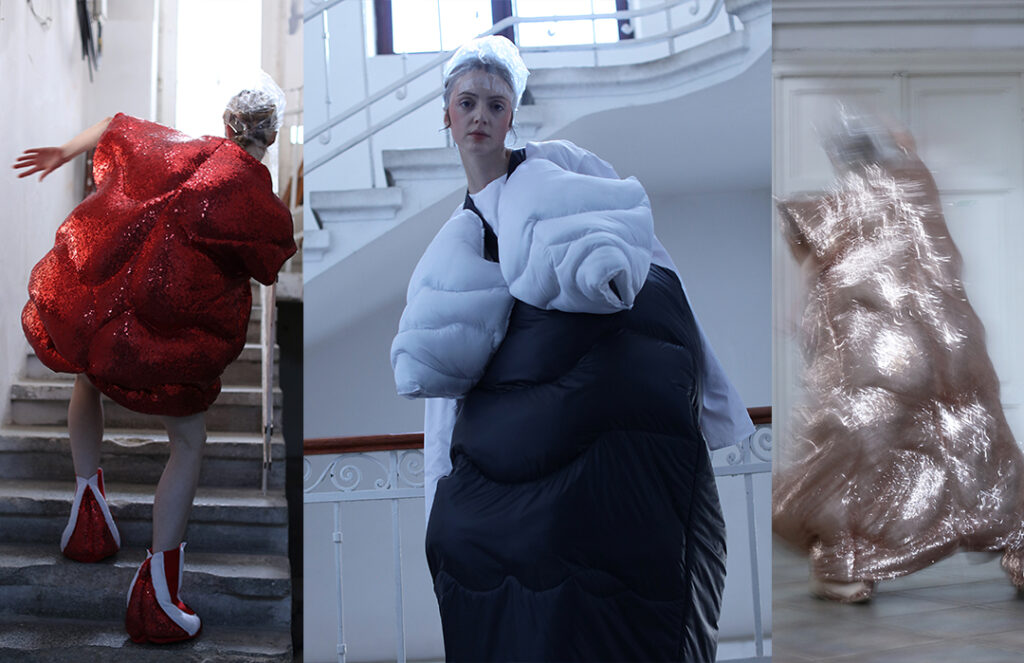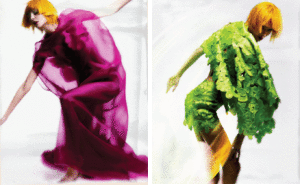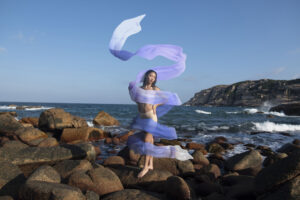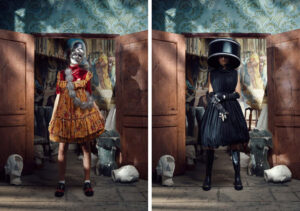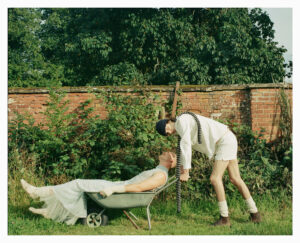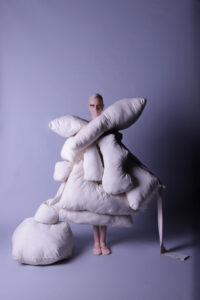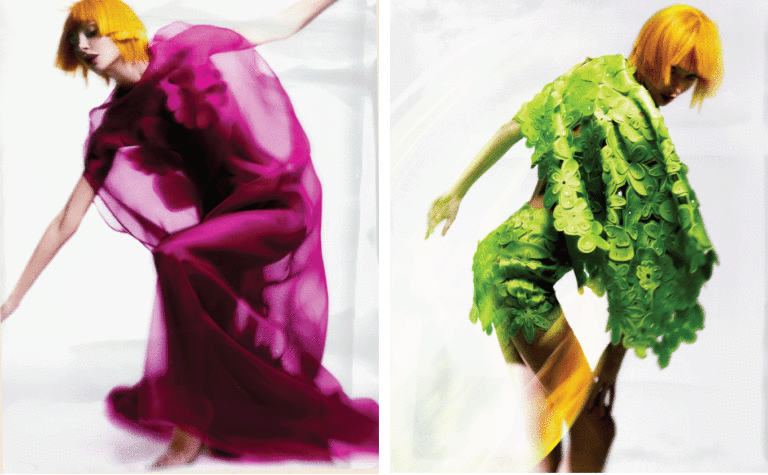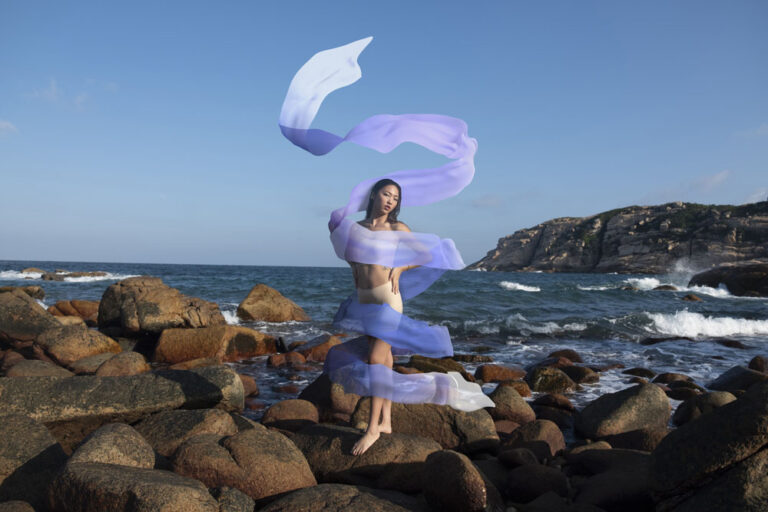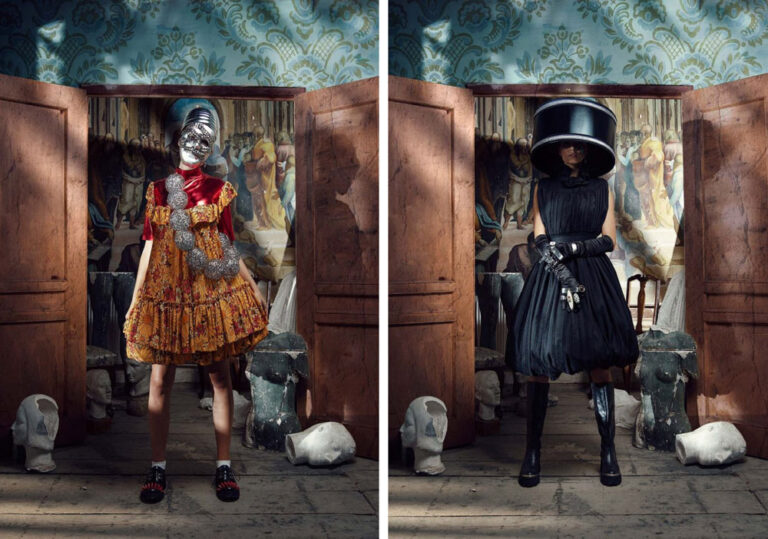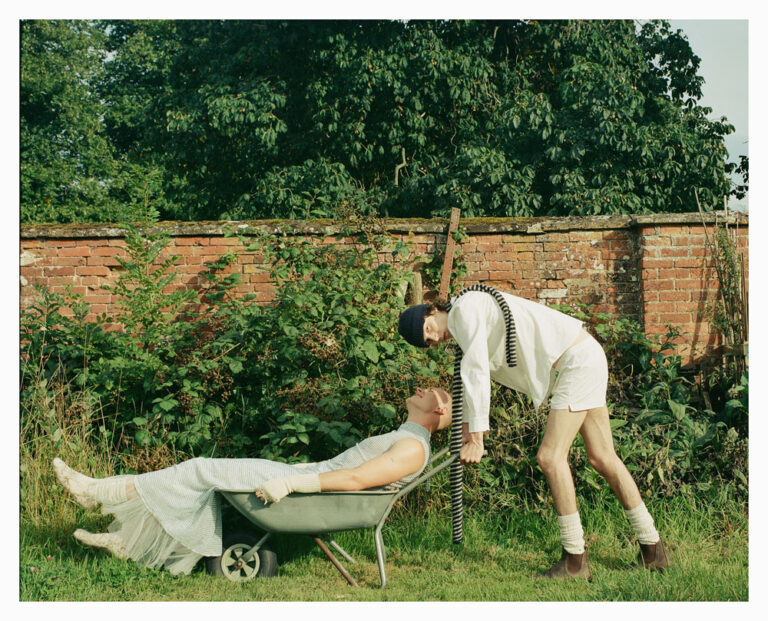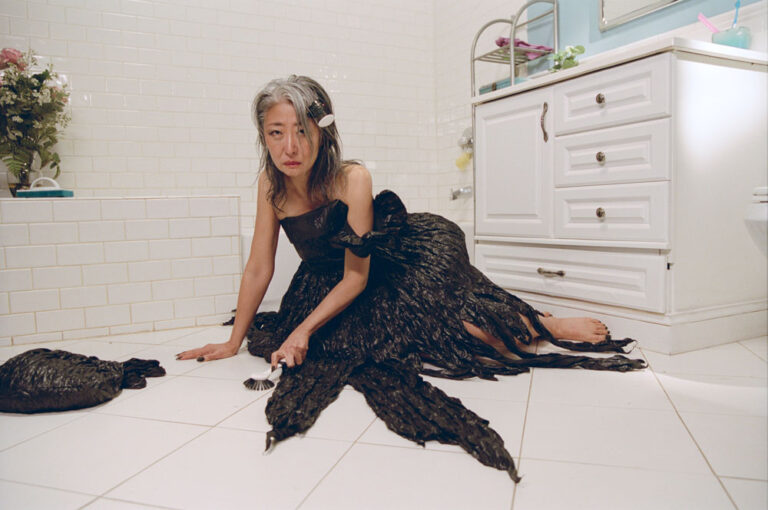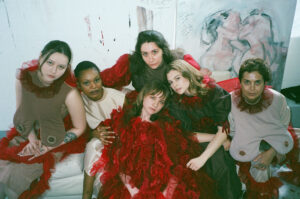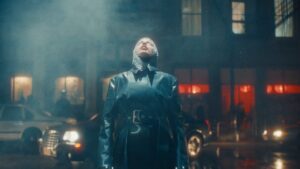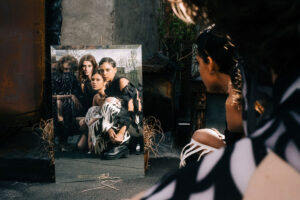Carmen Emanuela Popa is a talented young Romanian designer creating philosophical, conceptual pieces that challenge your imagination. Her work has appeared in major publications such as Vogue, Harper’s Bazaar and Marie Claire. We recently spoke with Carmen about her inspirations, aspirations, and her most recent collection Popa Fat X.
How does your reality shape the inspiration behind your work?
In fact, reality is the invisible engine of my work. It is a source of perpetual inspiration because everything that happens to me directly affects me in all the sensory planes of my being. The interaction with people, in different communication relationships, but also the dialogues that appear spontaneously or with some premeditation and which, sometimes, seem to have a very low level of love. It seems that the whole world is facing this drought of deep feelings, of compassion and of a kind of enthusiasm that should arise instantly when we interact with others. Social issues have always been at the center of my attention in terms of the creative discourse that prioritizes itself every time. The inner questions, a raw sincerity that defines me in a way to feel, see and assume things, the vision of life and the actions I undertake are also a major component in expressing an artistic concept in a complete and complex way. I believe that if people acted more vehemently as a result of this inner honesty, they would be better anchored in their own paths of self-discovery and perfection and could also enjoy a clearer and more honest sharing of the flow sentimental, which is not an energy to be stopped, but instead, is a pseudo-matter that can be the guide of our existence. I think that cross-disciplinary methods are very important in developing a project because the basic theme can be referred to in many areas of interest, thus the recipient is closer to their own life experiences. By exploiting the multitasking of creativity, the newest sources of inspiration and introducing the element of pro-humanism into the ultimate purpose of sharing, it means that the work acquires an ethical and aesthetical quality.
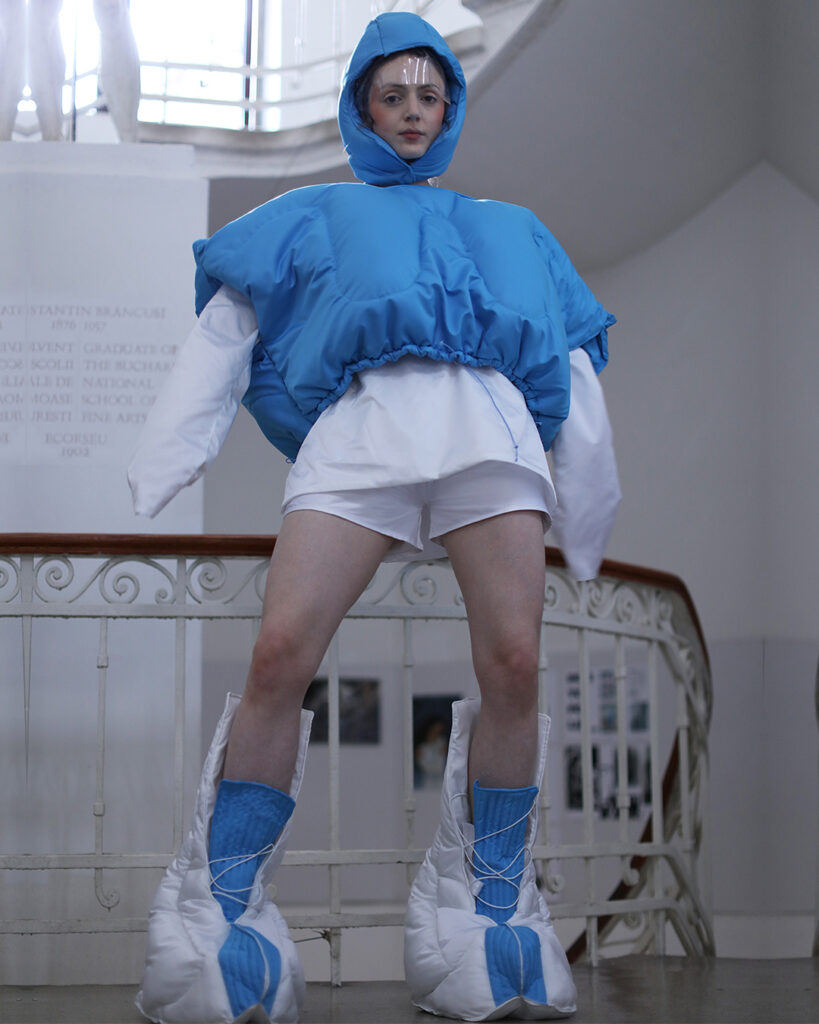
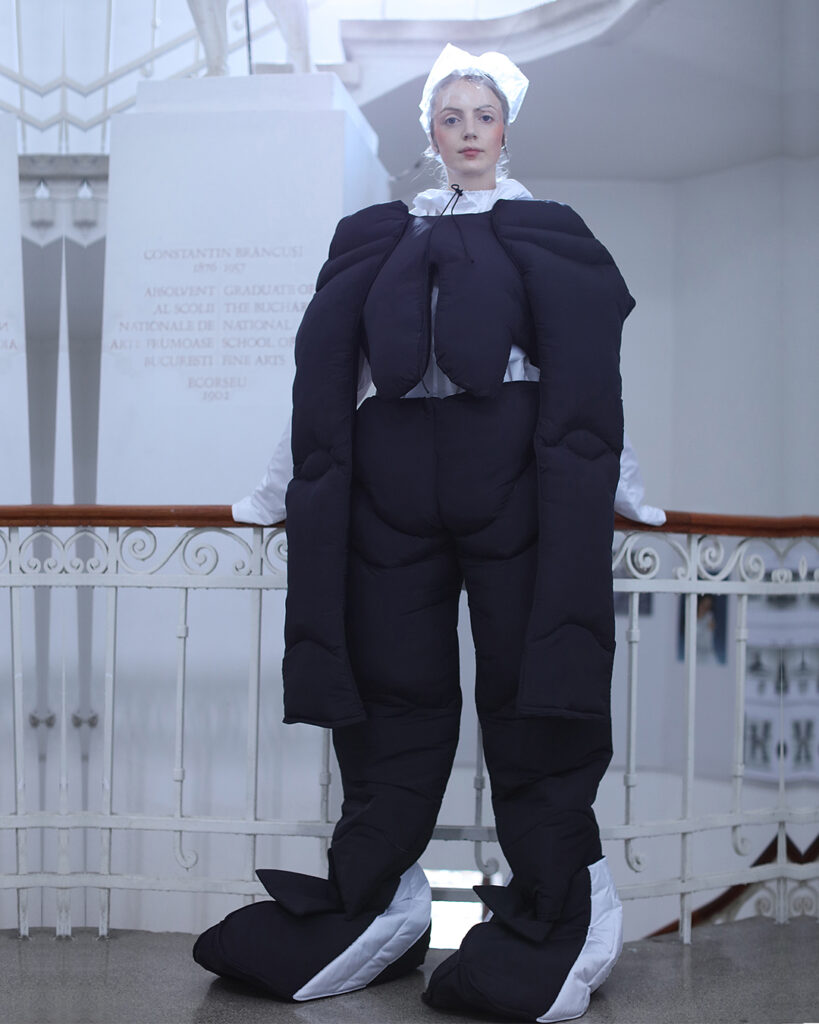
You’ve often cited your work as philosophical, are there any specific philosophers or philosophies that inform your creative process?
Philosophy has always been the closest friendly entity for me, because in this context of the existential depth it offered, I felt in the best state mood. I have always avoided ridicule and on the contrary valued what I thought rises above the superficial and trivial things. Philosophy is a cognitive orientation and once discovered you learn to live with it, you become aware of it and let it make you happy when you have a permanent relationship that reveals to you so many facets of reality, in a hypercreative and metaphorical way, philosophy is the indirect road that leads to the metaphor, the bar that the poem takes further. I read philosophy since the first years of high school, and it was one of the only niches of reality where I thought I was meeting the truth. Although at that time I was attracted by the skeptic philosophy because there were many questions to which I was looking for answers, especially regarding the condition of the artist and what should have been fair for him as a way of expressing himself so that he could create without limitations interior / exterior. But, later, in the first year of university, I discovered Heidegger and his work The Origin of The Art Work which served me as in a royal lunch long awaited all the answers I needed in this regard, with such depth, that the emotions overwhelmed me because this approach perfectly suited my way of living things, in other words my acute need to live completely in art, to claim it, worship it and serve it, all this being a complex process of my happiness as an artist. Also, Plato is the one who influenced me as much, The Dialogues were for me the most revealing oasis of truths, among which the most important of all, even than that of the whole being through the union of two human entities, that of the discovery beauty in its natural, pure state and further the conviction that life is worth living only in the service of contemplating this beauty.
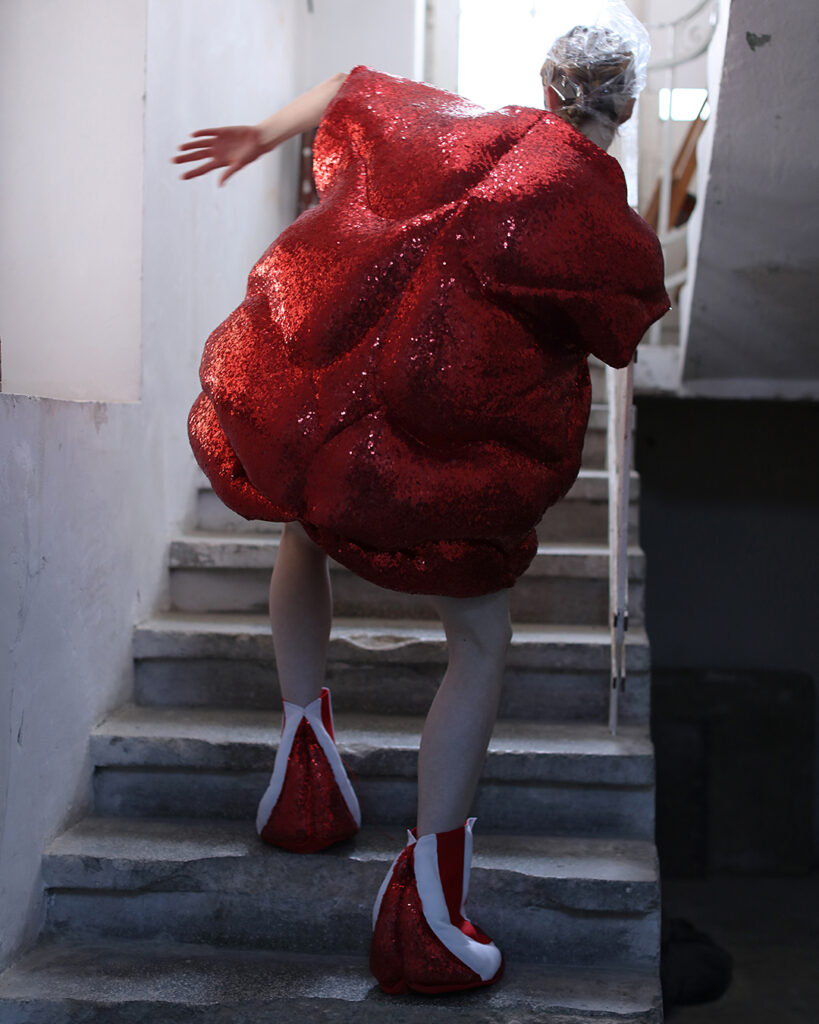
How has your childhood and upbringing informed your practice?
My childhood was a tumultuous one, especially because I was a very enthusiastic and curious child with a precocious thinking and a strong sense of love and positivism for those around me. That’s why I really liked to explore reality in a creative way. During the holidays, I used to go to my grandparents in the country and there a world opened for me that would become the substance and basis for my later ideologies, a paradisiacal world to which I relate even now making numerous parallels between nature vs urban vibes, traditional-future, eco-high-tech, innocence and metro-intellectual, hybrid culture, etc. My grandmother, during the winter, worked a lot in the weaving loom, so I was fascinated by the multitude of colors that the woolen threads had and then by the textile compositions that I saw materializing from her hands, which in addition to knitting manual with complex approaches sweaters and blouses. In parallel, I admired the lonely landscapes or the endless fields of green wheat, I felt that I had a strong connection with everything that was around me and that I empathized a lot with all these manifestations of matter, in a few words I had superlative feelings for everything that surrounded me, it was a type of unconditional love, the same for people. What seems to have led to this chanting of a hymn of contemplation and the care that is manifested in my art now. At the same time, spending time at home meant, in addition to school, also drawing classes, then I did the first still life and sketches. Also, my mother worked in a creative environment, namely in a machine embroidery department where she was doing an outstanding job, I was very familiar with white, immaculate fabrics and I also got to know the sewing machine. On the other hand, my father had drawn a lot in primary school and was somewhat oriented towards the rigor of academic drawing then, although he was also a very good colorist, I was often fascinated by his way of combining colors using colored pencils in my coloring books. My father had his own albums with images from the fashion world of the 60s / 70s, he was also passionate about car design and very much about cinematography, and books were also a passion alive. I think I carry this dream of his further to make art, calling on the means offered by contemporary contexts in many aspects.
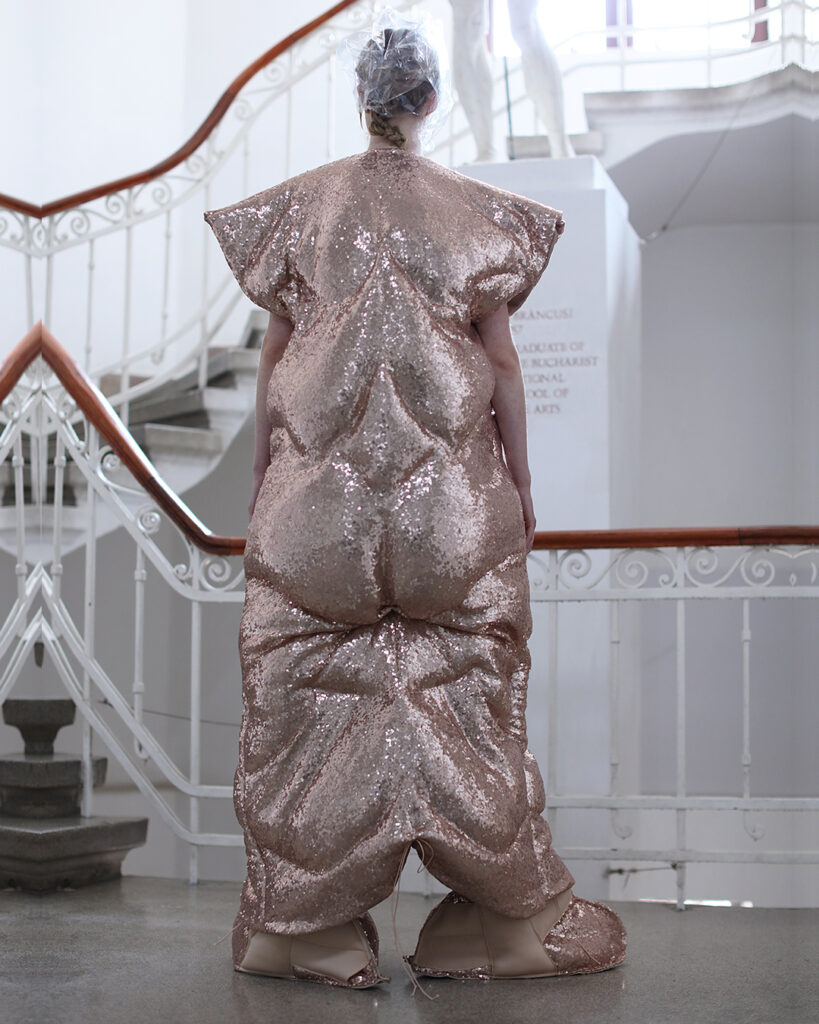
Your newest collection Popa Fat X is stunning, what was the process like in developing the voluptuous silhouette?
I worked intensively on this collection, and I believe that the practice previously accumulated in the technique used in this case also led to a perfecting of that method, to give the created object a 3D appearance, with well-defined shapes, a representation of the anatomy of the human body, an emphasis on an anatomical variant beyond conventional size standards. I worked with the extrapolation of the shapes on the template, then I used a textile filling that allowed the specific areas to gain volume. It is a process that requires skills and time and is very similar to the result of a textile sculpture, with well-defined lines and polished surfaces. This collection has a special background because it places me personally in a world of my own that I aspired to. The photos were taken at the National University of Arts in Bucharest, the place where I was admitted many years ago and now, in this case, it has become a surreal space with an overwhelming light. It is an exciting moment to see this entity now taking giant steps into this perimeter which to me has always been sacred because it identifies with art itself. Another exciting aspect is the direct encounter with a work by the Romanian sculptor Brâncusi, L’Ecorse, also made in this school in 1902, which reveals the muscles of the human body and which, for me, has always been a source of inspiration.
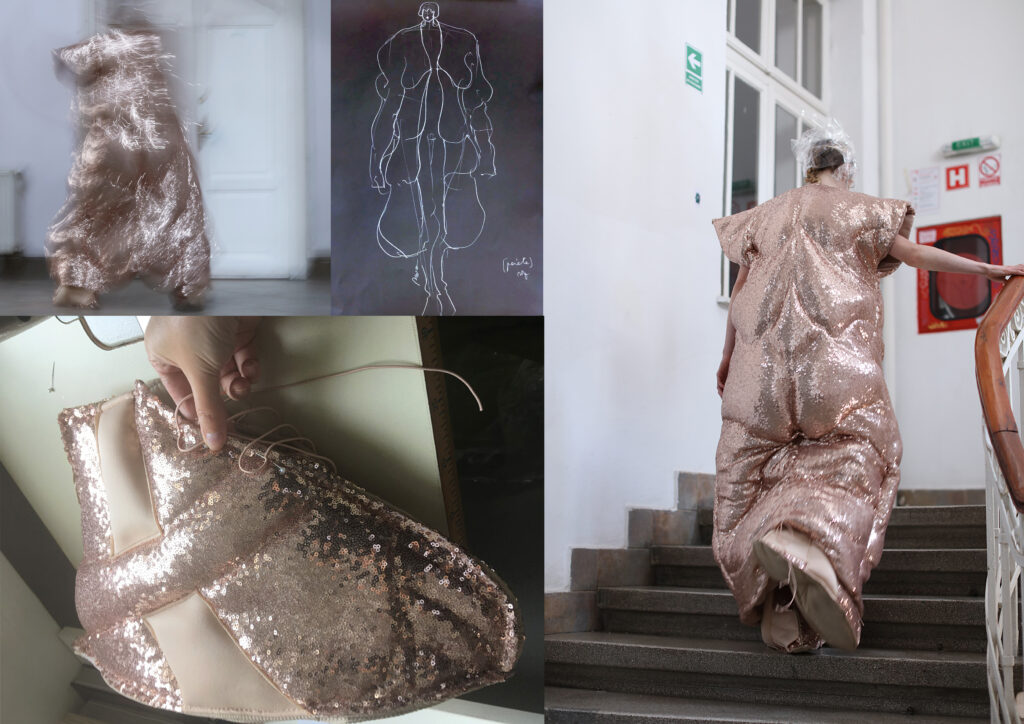
What was the process like in developing the textiles featured in your collection? What inspired them and how did you go about sourcing them?
Every time I visualize a project in terms of the materials used, they are instantly associated with the chosen theme and are most likely directly related to my style, which has influences from sportswear and is also defined as a contrasting association as well like the dual subjects approached by overturning the conventional. I chose these Fat silhouettes to be represented by a glam-luxury, eclectic texture, to highlight the visual impact of the antithesis between the drama of contemporary man and exuberance, the joy of living in the natural way of being for each of us, in acceptance and with the awareness of the values (X component) that we have beyond the aesthetic aspect, deeply hidden inside us and that shine like immaterial riches not yet discovered. Sequins versus neoprene, waterproof high-tech textures with added accessories such as sportswear elastic bands and transparent bandages that suggest a spiritualized aura of the character. Red is the strongest color in the chromatic spectrum that speaks with passion and persuasion about self-assurance but also about freedom and love, gold is the over-chromatic coat that ennobles and gives the subject a princely status as a super-being which would be wonderful to we all discover in ourselves, white refers to spiritual food, to a kind of immaterial milk that we all need to perfect our virtues and the cerulean blue and petrol tones evoke the inspirational and aspirational side of the character as well as the dose of melancholy and, often, sadness, which he experiences in his life. Regarding the procurement of materials, we have in our country a generous supply of raw materials and stores with a textile profile, from where we can purchase a varied range of materials for creative minds.
What other mediums aside from fashion do you see yourself using as a form of self-expression? Is fashion the only space you see yourself working in or does your creative process expand beyond the human form?
Fashion is a versatile pretext to combine visual, artistic rhetoric with messages that involve the human condition and a type of idealization of man in general from the perspective of self-knowledge, human interactivity and a valid set of values that aim to improve affective climates but also creative, thus placing man on a higher level with the achievement of some superlative daily goals. Another form of self-expression is that of writing. Poetry as a field for abstracting texts and experimenting with metaphor, having as a source of inspiration one’s own experiences but also contemporary human manifestations. The essay with subjects that analyze art from the point of view of the sensations and messages it conveys but also the hyper-potency of the creative act, is another way of expressing myself towards sharing some possible and fascinating worlds with others. These can be found at many times in the description of my own themes in conceptual fashion. My creative processes have always been multiple in terms of shaping artistic energy, and painting is a vast field that has accumulated many resources from an inner force that erupts day by day. Graphics is also a territory where a type of dramatic discourse of the human face and body is permanently placed on drawing paper covered with inks or acrylics. Domains that interconnect and are the solid basis in rendering fashion sketches, whether it is about experimental outfits or shoes that include in their story an interdisciplinary language, with an expansion of imaginative limits. Also styling and fashion photography are two extremely important areas in all my creative activity.
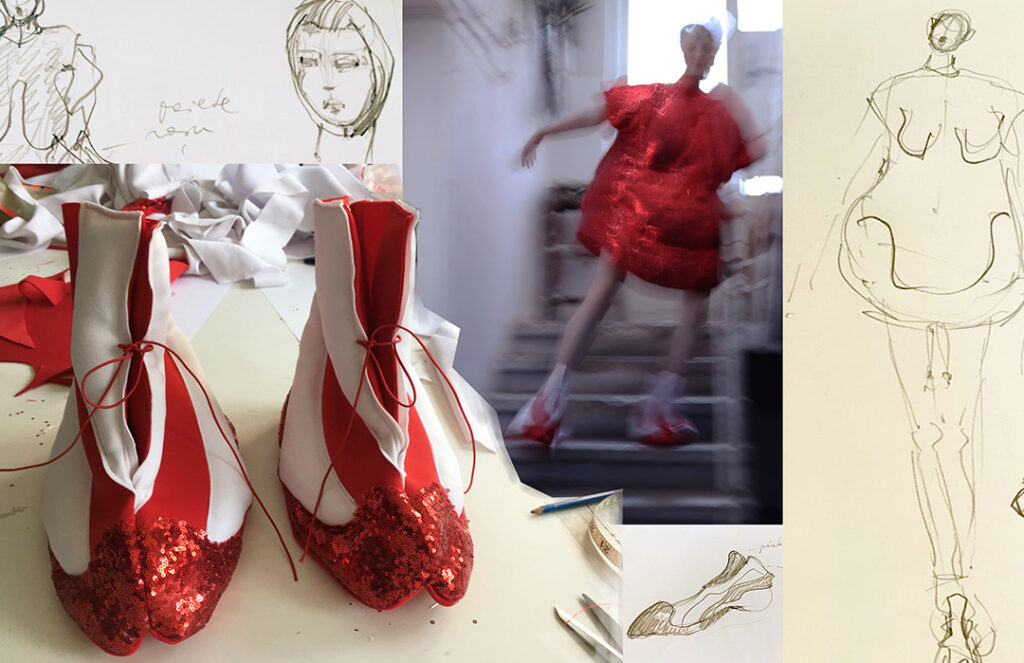
Are there any techniques you used or discovered while creating this collection that you want to explore further?
With each new project new things appear and with them the joy of being discovered. For example, in this collection I experimented with the extrapolation of size and shapes in modeling with the help of textile material, antithetical compositions of a synthetic polymer or impermeable materials with sequins, to create a new type of oversized, allegorical shoe, which, of course, I would like to perpetuate in other projects. I have used the technique of using several textile layers before and it seems that it turns into a kind of personal statement, because I think I express myself very well in this way, it could be about placing the shapes in relief, thus personalizing itself through visual and hyper tangible firmness. In any case, I really like to explore new realms of artistic expression, alternative techniques that, all put together, still render a certain deep sensitivity that characterizes me in terms of artistic vision of this world.
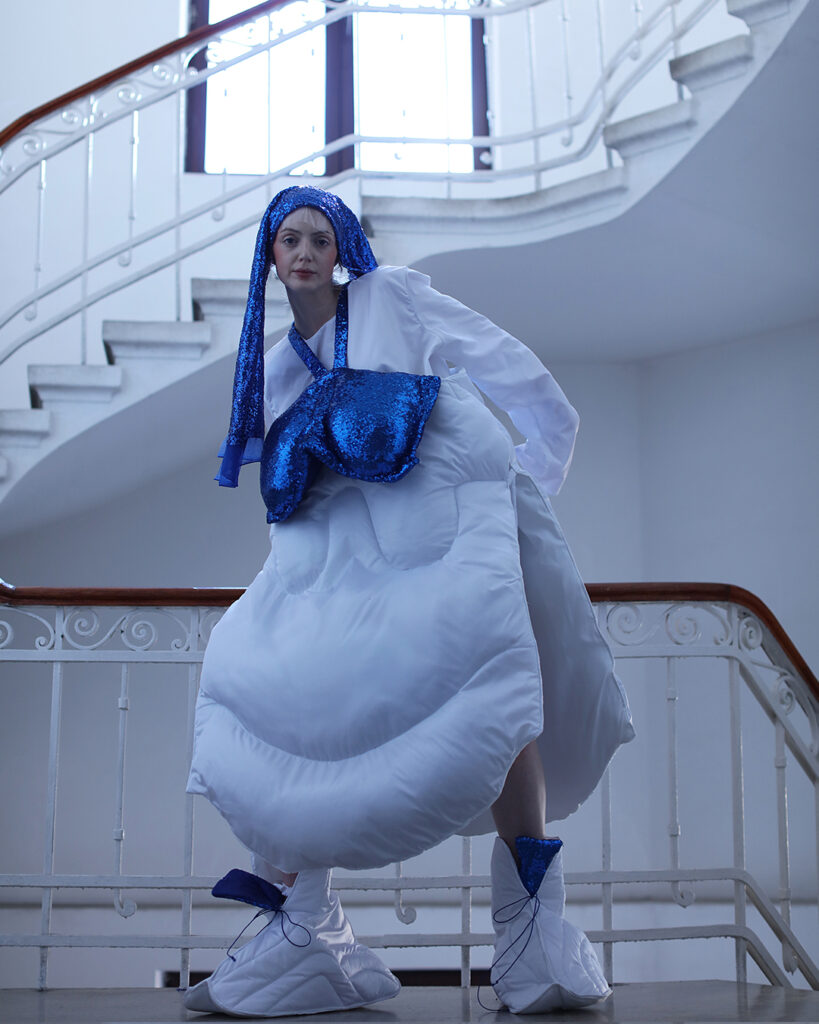
On a global scale, where do you see your work? Do you see yourself in mainstream retail spaces or is your work strictly avant-garde?
I believe that my main source of inspiration comes from the exploration of inner lives, based on emotions, the deepening of existential experiences and the placement of social, marital, and fundamental human rights issues in the center of attention, thus being a manifesto that can help and coagulate the sensitive feminist’s subjects or broadly anthropological. My works can be placed in contemporary art galleries because the created object is an object that can have a statuary resonance and can be identified with a singular character that has a plasticity discourse with some conceptual determination. The collections can easily be the source of the development of hybrid collections that can be expanded in number in retail spaces with avant-garde tendencies, an area that I generally want to be exploited as much as possible, so that there can be an evolution as more convincing in the creative clothing that reaches the consumer. I believe that the creative potential must be manifested on a large scale so that the world of tomorrow is built based on a freedom of expression and joy in the assimilation and spread of the creative act that is also reflected in the object with which we cover our bodies every day. We are not only beings who suffer, who have problems, see eco-anxiety, hybrid wars on a micro/macro scale or those of interrelationships, we are also creatively, emotionally beings and capable of offering a lot of consistency of human values, so we deserve a spectacular appearance on this earth, in all aspects.
Are there any artists or designers that you would love to collaborate with?
The passion for fashion design and the experience accumulated over the years but also through the skills acquired during the specific studies and the fashion art performances so far lead me to want to put my creative vision into practice in various collateral projects from the industry that tends to get more and more influenced by advanced inspirational rhetoric. I am convinced that a collaboration with specific brands in the avant-garde fashion sector would be spectacular, for example with Maison Margiela or Moncler, Adidas in their area of experimental fashion that they already have with various designers, to develop collections of the interference of styles and to increase the interdisciplinary potential to reveal authentic and emerging products. I believe that a collaboration at this level would be an excellent step forward so that my designs can benefit from advanced technology and logistic lines regarding the work applied in the fashion sector.
Where do you see your practice in 5 years’ time, is there anything specific you would like to achieve?
My process of creating and making clothing items is a consistent one, which is based on the accuracy of the details of the content ideas but also on the form. My time is dedicated to this activity in a maximum percentage, so I believe that soon new techniques and sources of inspiration will be discovered among the most profound and unusual, because this characterizes my work and I want to experience new challenges in this sense. Also new exhibitions and collaborations for capsule collections can be predicted. But most of all, in the next five years I want to further develop my own brand that offers outfits specific to my artistic statement for a representative customer niche that values the creative act and identifies with the strength that this kind of fast imagination has. At the same time, I want to launch a line of shoes based on the same principles of exuberance of the unexpected, which gives a certain type of power to the wearer. I think the field of fashion is very generous in terms of creativity, in fact what attracts me most in my work is to challenge the intellect and artistic sense by placing them in an ongoing dialogue.
For more of Carmen’s work make sure to check out her work at The Next Exhibition, The Winner| Post Bauhaus Experimental Fashion taking place in Bucharest at the SENAT Gallery from the 6th to the 12th of September 2022. Carmen’s new collection is set to be presented digitally during London Fashion Week at the Profile Designer section starting on September 10th for the official LFW which takes place from the 16th to the 20th of September 2022. Check out the link: https://londonfashionweek.co.uk/designers/carmen-emanuela-popa#content for more.
To learn more about Carmen’s work, follow her on Instagram @carmenemanuelapopa


